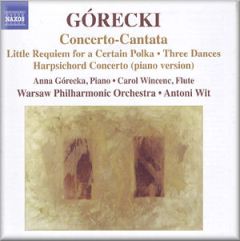Henryk Gorecki - Concerto-Cantata, etc (2012)
Henryk Gorecki - Concerto-Cantata, etc (2012)

Male requiem dla pewnej polki (Little Requiem for a Certain Polka), Op.66 1. I. Tranquillo 2. II. Allegro impetuoso – Marcatissimo 3. III. Allegro - Deciso assai 4. IV. Adagio cantabile Concerto-Cantata, Op. 65 5. I. Recitativo: Lento (quasi molto lento) 6. II. Arioso: Lento assai tranquillissimo - Cantabile – Dolce 7. III. Concertino: Allegro 8. IV. Arioso e corale: Lento - Tranquillo cantabile – Dolce Harpsichord Concerto, Op. 40 (version for piano and orchestra) 9. I. Allegro molto 10. I. Vivace marcatissimo 3 Dances, Op. 34 11. No. 1. Presto, marcatissimo 12. No. 2. Andante cantabile – Tranquillo 13. No. 3. Presto Warsaw Philharmonic Orchestra Anna Górecka (Piano) Carol Wincenc (Flute) Antoni Wit – conductor
Having produced what was probably the most commercially successful symphony since the Second World War, what was Henryk Górecki to do next? Some of the answers are given in this CD, which includes the world première recording of the Concerto-Cantata. Both this piece and the Little Requiem - which has been previously recorded - come from the early 1990s when the influence of Arvo Pärt seems to have been particularly strong on Górecki. Both composers shared a similar aesthetic – a move away from the serialistic and avant garde techniques of their youth to a style which has been described not unfairly as ‘holy minimalism’. But there is a degree more strenuousness and muscular about Górecki’s music in these works. We have the tolling bells familiar from such works as Pärt’s Cantus in memoriam Benjamin Britten, but Górecki’s writing for the strings sometimes breaks out violently and there are unexpected eruptions from the brass in the Little Requiem. It should be noted, incidentally, that despite the use of titles for this and the Concerto-Cantata which might lead one to expect vocal pieces like the Symphony of Sorrowful Songs, these are purely instrumental works. The brass eruptions in the Little Requiem form the second movement in a symphony-like structure, with tolling repeated piano chords underpinning the texture. The music subsides back into a very beautiful clarinet solo before the tolling bells return. Anna Górecka (the composer’s daughter) comes into her own in the dynamic and scherzo-like third movement, the ‘polka’ which is almost jazzy in feel. The final movement returns us to the calm of the opening.
The Concerto-Cantata is a very much less troubled work, and the gentle suspensions from the flute over the static background produce a feeling of untroubled calm. This is music of real beauty, balm to the troubled soul, and the sudden eruption of the third movement into a Shostakovich-like scherzo comes as a real shock. The grandiose climax brings a mood of frantic triumph which is not to be found elsewhere in Górecki. Incidentally the composer here at the end uses (from 4:43 onwards) a repeated syncopated triplet phrase from my own composition The Fall of Gondolin (written six years earlier but not publicly performed at that time, so simply a coincidence of course) which brought a moment of delightful and very personal familiarity! The final movement returns us again to the calm of the opening. This is a superb piece and it is very surprising to discover that it has not been recorded in nearly twenty years since it was written.
The Harpsichord Concerto is a much briefer and more turbulent work, and it works well in its guise for piano. It has previously been recorded in its original harpsichord version with string quartet but this seems to be its first recording for piano and orchestra. The flavour here is almost like Prokofiev. The piano lends a percussive edge which works better for that instrument than it did for the harpsichord. The use of a full orchestra helps too.
The much earlier Three Dances do not sound like the Górecki we know and love at all; the first is a Bartók-like Presto marcatissimo which is firmly in the line of familiar central European folkdance arrangements. Even the calmer central movement sounds more like Kodály or Janác(ek than anything we would nowadays identify as Górecki. Only the static harmonies betray any hint of the composer of the Third Symphony. The final dance is a Presto perpetuum mobile which again brings reminiscences of Prokofiev, this time of the Overture on Hebrew themes.
There are other recordings of the Little Requiem, the Harpsichord Concerto and the Three Dances, notably of the first two by the London Sinfonietta (coupled with the beautiful Good night). These performances are fully the equal of those rivals that I have heard. The fact that this disc contains world première recordings of the Concerto-Cantata and the Harpsichord Concerto in its piano-and-orchestra form makes this issue self-recommending. --- Paul Corfield Godfrey, MusicWeb International
download: uploaded anonfiles yandex 4shared solidfiles mediafire mega filecloudio
Zmieniony (Piątek, 29 Listopad 2013 15:24)








